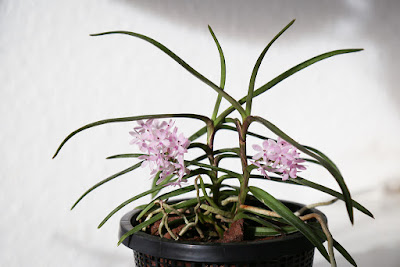Ascocentrum christensonianum is native to Vietnam. This relatively recently discovered orchid was found in southern Vietnam, about 20 km north-west of Phan Rang. Plants were encountered in a narrow valley along the Song Cai River between two adjacent mountain ridges. This region, located only 100-150 m above sea level, is a dry area, covered with young, bushy, partly lost monsoon trees.
Ascocentrum christensonianum orchid, also called as Christenson's Ascocentrum (named after the American botanist and orchid enthusiast Christenson), Vanda christensoniana, is a species of the genus Ascocentrum. This species was described by Haager in 1993.
IDENTIFY ASCOCENTRUM CHRISTENSONIANUM ORCHID
Ascocentrum christensonianum is native to Vietnam. This relatively recently discovered orchid was found in southern Vietnam, about 20 km north-west of Phan Rang. Plants were encountered in a narrow valley along the Song Cai River between two adjacent mountain ridges. This region, located only 100-150 m above sea level, is a dry area, covered with young, bushy, partly lost monsoon trees.
It is a miniature to medium sized, hot to warm growing, monopodial epiphyte that has an erect stem enveloped completely by leaf bearing sheaths carrying strap shaped, acutely tridenticulate apically leaves. The leaves are 10-16 cm long and 0.5-0.8 cm wide. Their color is fern-green when they grow in shade, but they get intense red when they grow in full sun.
Christenson's Ascocentrum blooms in the spring and fall on an erect, axillary, 4 to 6" (10 to 15 cm) long, several flowered inflorescence. Flowers are 1.4 cm in diameter, with a slightly bucket shape are arranged along almost the entire length of the inflorescence. They are pale pink, pink or lavender-pink and have a pink lip, which has a purple spot in the middle.
ASCOCENTRUM CHRISTENSONIANUM CARE AND CULTURE
Cultural information should only be used as a guide, and should be to be adapted to suit you. Your physical location; where you grow your plants, how much time you have to devote to their care, and many other factors, will need to be taken into account. Only then can you decide on the cultural methods that best suit you and your plants.
Light:
Ascocentrum christensonianum needs a light level of 35000-45000 lux. The plants will probably be in better condition if they are not exposed to direct sunlight. Strong air movement should be ensured all the time.
Temperature:
The average temperature of the summer day is 32 ° C, the night 23 ° C, and the daily difference is 9 ° C. The average temperature of the winter day is 27-28 ° C, the night 19-21 ° C, and the daily difference is 6-8 ° C.
Humidity:
For most of the year, Ascocentrum christensonianum needs the humidity of 75-80%, but for a period of about 1 month during the autumn rainy season it increases to 85%.
Substrate, growing media and repotting:
This species can be mounted on cork or tree fern rootstock, it is necessary to ensure high humidity and summer watering at least once a day, and in very hot and dry weather even several times a day. You can also grow in pots or baskets filled with any very loose, easily drying substrate, such as medium-sized bark pieces with perlite and charcoal.
These plants are particularly badly reacting to stagnant, stale or soggy soil, so they should be replanted immediately, when the substrate begins to decompose. Repotting is best done when new roots start growing, because then the plants will stabilize in the shortest possible time. Care should be taken with fragile young roots.
Watering:
Ascocentrum christensonianum should be watering daily during active growth, but their roots must always dry between watering. Fogging between watering carried out in the early morning is very beneficial, especially during hot and dry weather.
Fertilizer:
It is recommended to feed weekly 1/4-1/2 of the usual dose of fertilizer for orchids. From spring to mid-summer, it is more useful to use a fertilizer with a high nitrogen content, and then to the end of autumn - with a high content of phosphorus.
Rest period:
In winter, when Ascocentrum christensonianum are not in the active growth phase, the amount of water should be reduced, especially if they are grown in conditions of a dark short day. If the amount of water is limited, fertilization should also be reduced. When new growths appear in the spring, regular watering and fertilization are resumed.















COMMENTS